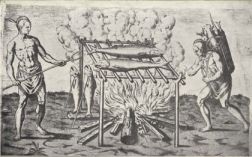
Technicians will be working on our network from 7 a.m. to 1 p.m. on Saturday, Nov. 15th. We apologize in advance for any downtime you may experience during this time.
Copyright Notice: This article is from the Encyclopedia of North Carolina edited by William S. Powell. Copyright © 2006 by the University of North Carolina Press. Used by permission of the publisher. For personal use and not for further distribution. Please submit permission requests for other use directly to the publisher.

References:
Christian F. Feest, "North Carolina Algonquians," in Bruce Trigger, ed., Handbook of North American Indians, vol. 15 (1978).
Maurice A. Mook, "Algonkian Ethnohistory of the Carolina Sound," Journal of the Washington Academy of Sciences 34 (15 June, 15 July 1944).
Image Credit:
"Indians Cooking Fish." From the John White drawings in Ashe's History of North Carolina. Courtesy of UNC's Documenting the American South. Available from https://docsouth.unc.edu/nc/mcpherson/mcpherson.html#p76a (accessed May 23, 2012).
Green, Michael D. "Pasquotank Indians." NCpedia. State Library of NC. 2006. https://www.ncpedia.org/pasquotank-indians.